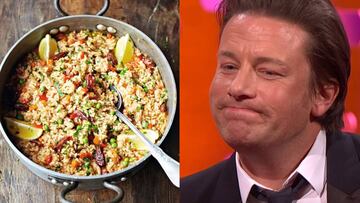Throwback to when when Jamie Oliver’s paella recipe enraged an entire country
Jamie Oliver turns 50 today and we look back at his disastrous take on the classic Valencian dish

The famous British chef was born 50 years ago today and we look back at when he caused an international incident by including chorizo in paella.
On the east coast of Spain, from Catalunya in the north to Murcia in the south, is where you will find the best rice dishes in the country with Valencia as the undisputed home of the most well known one of all - paella.
Paella is so deeply ingrained into Spanish food culture that it features on menus wherever you go in mainland Spain and its islands. However, it is a dish that has undergone a number of mutations - ingredients swapped for others, different cooking utensils used, either for ease or to reduce cooking times.
Jamie Oliver is still a hated man in Spain because he put chorizo in paella in 2016 pic.twitter.com/9ObNxfHprq
— Liam (@liam_scfc) May 20, 2022
Like practically every traditional dish under the sun, from Spaghetti Carnonara to Pizza, there is much debate about what makes them authentic, how they need to be cooked and served, which ingredients should be used in their making and which ones should never, under any circumstances, be used.
Paella falls right into that category and always has - long before British chef Jamie Oliver almost caused an international incident by cheekily adding a few slices of Spanish chorizo to his twist on Spain’s beloved rice delicacy.
There was quite a bit of backlash on social media to Jamie’s chorizo-infused concoction - most of it good-natured. Spaniards were quick to tell Oliver that his rice dish should not be called paella and adding chorizo, in this specific case, makes no sense.
Chorizo is widely used in Spanish cooking, so what’s the problem? Before we get to that, we need know what Spanish people, and especially those from Valencia, consider to be paella.
Arroces de Segis 🙌 pic.twitter.com/uJO4037N27
— Esteban Sancho (@EstebanSaancho) December 23, 2017
What makes a paella authentic?
José María Muñoz, who has run El Ventorrillo Murciano in central Madrid, one of the capital’s best arrocerías, for the past 25 years, explains: “Paella is specific to Valencia - it’s exclusive to that region, and that’s why for the rest of Spain, the dish that we make, we call arroz (rice). You can eat a top quality, exquisite rice dish anywhere in Spain - it’s just that we don’t tend to call it paella".
Domingo y apetece paella! Te recomendamos El Ventorrillo Murciano, buenísima! http://t.co/MW22jzZ1zL 🍴😍 #paella pic.twitter.com/0YxqPNpGto
— Madrid Me Espera (@madridmeespera) June 28, 2015
Paella is cooked in a paellera - a shallow, flat steel pan with two handles - that is what gives the dish it’s name so anything that is cooked in a different pot or pan is not strictly a paella.
Paella is a communal dish, best enjoyed shared; so rather than being served, the paellera sits center stage in the middle of the table so everyone can happily tuck in, spooning out potions onto their own plates.
So that’s the basic principal, now let’s get into the more intricate details. The type of rice used to make paella is also very important as is the quantity. Generally, there are three varieties used: Bomba, Senia and Albufera - round, pearly white, short-grain rice with a low starch content which can absorb liquids more readily than other types.
Cuando Jamie Oliver descubrió a Tuiter Españita al poner chorizo en la paella, mítico! pic.twitter.com/uAo6MDw1Ww
— Alex 😙🎶 (@afernandezeyre) January 18, 2024
And don’t use too much. The best paellas will have just one, thin layer of rice - so that they cook evenly and absorb stock better. While it’s tempting to add more rice, you’ll lose flavor. And unlike risotto, paella rice needs to be left to cook on its own without stirring.
Another essential factor - the color. The rice should be a bronzed, golden color - not the bright yellow versions sold in tourist hotspots, which uses yellow food coloring (colorante) - full of nasty E numbers. Some cooks might use turmeric as a substitute, which also turns the rice yellow and does affect the taste, but at least it’s natural.
#RecipeoftheDay is Chicken & Chorizo Paella. Good Spanish food doesn’t get much better! https://t.co/YkFOyzeMtR pic.twitter.com/S3MhRFdPMA
— Jamie Oliver (@jamieoliver) November 17, 2015
The right kind of paprika to use in paella and Spanish rice dishes
An authentic paella gets its color in several ways. Some cooks like to toast the rice in a heated, empty pan before adding ingredients and stock. The golden color comes from saffron threads and sweet red bell peppers in different forms which are added to the sofrito.
Dried Choricero Peppers or Ñoras are rehydrated by soaking in water then the flesh is scooped out, seeds removed and added to the sofrito. It is also used in powdered form - paprika, and this is the main culprit, the ingredient right at the heart of the Jamie Oliver debacle.
There are several different types of paprika (pimentón) used in Spanish cooking: sweet, hot spicy, sweet and sour (agridulce) and smoked (ahumado).
The sweet variety (pimentón dulce) has a subtle taste which is why it is best suited to paella/arroz - spicy and smoked paprika meanwhile is used in making chorizo sausage - its flavors are too spicy, too smokey and too overpowering, so it doesn’t go well with paella. Another reason is its high animal fat content, which makes the rice cloggy - as does onion, so purists will say yes to garlic, but no to onion.
Today's #RecipeOfTheDay has a bit of everything! Comforting & flavoursome paella: https://t.co/9X28qvXVC2 pic.twitter.com/Tt6MtALXQ4
— Jamie Oliver (@jamieoliver) April 9, 2016
The difference between paella and Jamie Oliver’s “Rice with things”
An authentic Valencian paella is flavored with ingredients such as rabbit, snails, green beans and rosemary.
Another topic of debate is whether paella should have socarrat - the slightly caramelized rice that has stuck to the bottom of the pan due to overcooking. It’s question of taste - some people like it, others don’t.
There are many other versions of this exquisite dish but these come under the general umbrella termed arroces - rice dishes rather than paella, even though they are cooked in the same way - eg. Arròs del Senyoret, which has all the shells and other messy bits removed before serving, Arròs a Banda, Arròs negro... etc.
It goes without saying that Jamie Oliver is an excellent chef but his ‘paella-chorizo’ fusion, while an odd combination, would be called Arroz con cosas by natives (“rice with things”). Lots of people in Spain make Arroz con cosas, using whatever ingredients they like - it’s just considered sacrilege to label it paella.
Common ingredients that you will find in Spanish rice dishes cooked in a paellera include: artichokes, cauliflower, red and green bell peppers, peas, asparagus, chickpeas, lobster, chicken, ribs...
Arroz con cosas or paella... it might seem petty to some but once you have tasted the real deal, there’s no turning back.
Related stories
Get your game on! Whether you’re into NFL touchdowns, NBA buzzer-beaters, world-class soccer goals, or MLB home runs, our app has it all.
Dive into live coverage, expert insights, breaking news, exclusive videos, and more – plus, stay updated on the latest in current affairs and entertainment. Download now for all-access coverage, right at your fingertips – anytime, anywhere.


Complete your personal details to comment